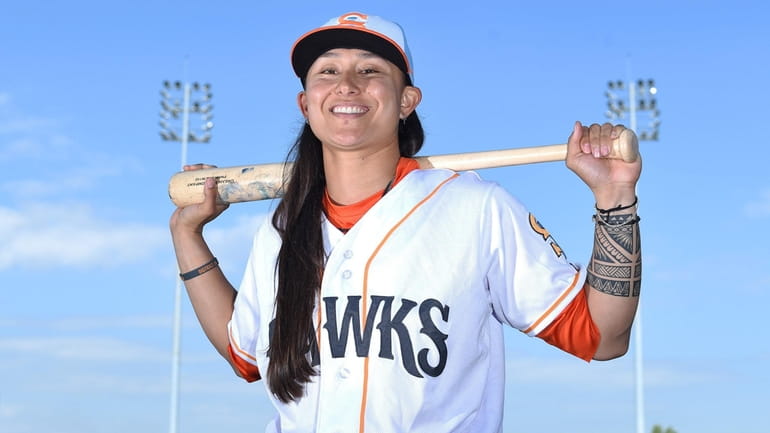Kelsie Whitmore, first female baseball player to start in Atlantic League, visits Long Island Tuesday night

Kelsie Whitmore, female baseball player for the Staten Island FerryHawks, poses for a portrait in between doubleheader games against Gastonia at Richmond County Bank Ballpark on Sunday, May 15, 2022. Credit: James Escher
Kelsie Whitmore didn’t let herself say it out loud until about six months ago, the weight of the dream heavy in the way it is when you want something as badly as she does.
She was speaking with a coach when he asked her what all this was for — the tireless hours of practice, the way she honed her pitches, and how she competed against men who weren’t shy when talking about their aspirations.
Whitmore had taken every possible step to pave the way toward professional baseball, except the one in which she finally said, out loud, that that’s what she was aiming for.
But when her coach finally asked her point-blank, “I said I wanted to play professional baseball and he said, ‘That’s the answer that I was looking for,’ ” she said last month while visiting Yankee Stadium. “Don’t be afraid to say it out loud and tell people. Don’t be afraid to do that . . .
“I kept it in for so long and he could tell it was something I wanted . . . Ever since then, I took the initiative to not be afraid of saying what I want to do and taking that step to go outside my comfort zone.”
See, there are no such things as comfort zones when you’re blazing a trail, and that’s exactly what Whitmore, 23, has done since that fateful conversation.
Earlier this month, the pitcher and outfielder, who signed with the Staten Island FerryHawks, became the first woman to start an Atlantic League game. She also came in as a reliever in a bases-loaded jam on May 4 and retired former major-leaguer Ryan Jackson on a flyout.

She had less success in her next outing, when she was charged with six runs. She allowed three runs, loaded the bases and the reliever after her — a position player — gave up a grand slam.
At the plate, she is 0-for-3 with a walk and a run scored.
On Tuesday, she and the FerryHawks bring their show to Long Island to play the Ducks, and along the way, her story grows. At 5-6, with long hair that spills out loosely under her cap, Whitmore stands out visually, but she fits in rather seamlessly. She has a fastball with a good amount of run, a changeup with a vertical break that makes it read like more of a splitter, a slider and a curveball. She’s working on her circle change.
She’s been playing baseball since Little League and was a member of the U.S. women’s national baseball team by the time she was 16, winning gold in the 2015 Pan American Games. The righthander and San Diego native played softball at Cal State Fullerton, training with the baseball team, and was named the Big West’s player of the year in 2021. Whitmore also played with the Sonoma Stompers, a men’s independent league team, for two seasons.
And while the Atlantic League isn’t affiliated with Major League Baseball, it is partnered with it, with about 40% of its players having major-league service time. It is, for some, a steppingstone. And for Whitmore — and baseball in general — it opens up the potential of a woman playing at the highest level.
“That’s a groundbreaking event for us,” baseball commissioner Rob Manfred said at a recent meeting with sports editors. “It gives you an honest-to-God, real-life example of what we’ve been saying for years — aspirationally, someday, we’re going to have women playing professionally for us. Think about the last few years — Kim Ng getting the GM job [with the Marlins] . . . in terms of coaching and managerial and the minor-league level, and the player level, those are big changes for us that we need to replicate at scale.”
And though there certainly are physiological differences that make something like that a challenge, other barriers are slowly lifting, said Rachel Balkovec, manager of the Tampa Tarpons, the Yankees’ Class A affiliate. She became the first full-time female manager in minor-league baseball.
“There are differences between men and women, but the thing is, if a woman is good enough, if she can throw the ball hard enough, with enough movement or whatever, I think we’re in a time where that will be accepted more,” Balkovec said in January, three months before Whitmore signed.
“If she has the talent, especially with tech and measuring things, you really can’t easily discredit someone if you don’t like them for whatever reason. It’s there in the numbers. If there’s a woman that’s good enough to compete, I feel she will be accepted and supported. We’re in a different time, obviously. I think it’s possible that there’s someone out there that can do it.”
She added then: “You might want to keep an eye out for Kelsie Whitmore.”
Manfred also made it clear that he believes women in baseball is good for the bottom line. A league survey conducted in 2010 indicated that 45% of baseball fans were women, but another study by Statista, conducted in 2021, said that only 12% of women consider themselves “avid” fans, compared to 31% of men.
Ticking up that number — the number of women who are invested, go to games and buy merchandise — is key to growing the sport, Manfred said. And some of that happens naturally when women see themselves represented on the field, such as in the form of coaches, such as the Giants’ Alyssa Nakken, who is the first female field coach in MLB history, or in front-office roles, such as Ng.
“You want the product . . . to look like the country so that you appeal to a broad fan base,” Manfred said. “At the end of the day, the clubs control those hirings. What do we do? We encourage. We educate. We create programs designed to produce quality candidates that we introduce and make available to the clubs in order to produce the kind of diversity that we’re looking for.”
But it has to be more than just diversity for diversity’s sake, and Whitmore is adamant about being just like any other baseball player. When she’s asked about her goal, she makes a point of it.
“Playing baseball at the highest level, that’s the goal,” she said. “If you ask any other guy in the league what his goal is, mine is the same thing — to get to the next level and play at the highest level I can possibly play at.”
Reactions, she said, have been largely positive. From that conversation with the coach who told her to verbalize her aspirations out loud, to interactions with other players now, it appears professional baseball, at least philosophically, is moving to a place where a female player breaking into the big leagues wouldn’t produce the vitriol it might have years ago.
“For the most part, people have been really positive, supportive — a lot more than I expected them to be, to be honest,” she said. “I was expecting something different. But for the most part, there’s been a lot of support. A lot of friends and family back home that are really supportive and just being there for me, so it’s been good so far.”
So, a woman in the majors?
“If she’s good enough and works hard enough and she deserves it, I don’t see why not,” Whitmore said.
And why should she think otherwise? She’s already done the work of breaking the first barrier.
With Mike Rose

